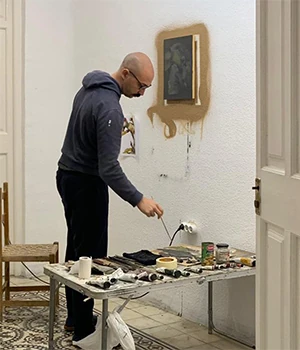
BIO
Ignacio Estudillo (Jerez de la Forntera, 1985) studied at the Seville Fine Arts Faculty ‘Santa Isabel de Hungría’. He learned with other artists and acquired his professional skills by attending courses, exhibitions, and painting contests.
He has been awarded several prizes or recognised in different events, including the ‘Fine Arts Biennial Rafael Botí’, ‘Premio Emilio Ollero’, ‘Premio Díaz-Caneja’, Gold Medal at the Autumn Exhibition of the Seville Fine Arts Academy, ‘Premio Colección Los Bragales’ at the ‘Feria de Estampa, 2017’. He has been awarded twice the ‘BP Portrait Award’ arranged by The National Portrait Gallery of London. Estudillo has been granted several studentships, including the ‘Mario Antolín’ – a BMW Painting Prize award – ‘Antonio Gala’, ‘Encuentra’ and ‘Iniciarte’.
There are artworks by Estudillo in the BMW, CAC Málaga collections, as well as in the Cosentino, Antonio Gala, María Cristina Masaveu-Peterson, Rucandio, Rafael Botí o Giorgio Cini (Venice) foundations. The Rafael Zabaleta and the Casa Ibáñez museums hold artworks by Estudillo.
He currently lives and works in Granada.
ARTWORK
LANDSCAPE CONSTRUCTION
This is a series of pieces in different formats in which you can see genuine natures. Some belong to the world of humanity, and some are leafy, violent and harmonic views. These paintings are elaborated through the conjunction of various organic actors. Both the referential and the painterly act and coexist as equal experiences within the format, within another reality.
These paintings form scenes with no spatial references as they lack ground, sky and horizon. Consequently, these scenes cannot be looked over nor provide any possibility for locating oneself. Also, the paintings contain plenty of items and obstacles that may cause harm and do not allow your access. No space left, not even for another brushstroke. These are images with plenty of diagonal lines here and there yet. Showing no depth to run through. Fleeing from the trompe l’oeil and spatial equivalences, they focus the look on the surface. These are artefacts that insist on being looked at as paintings.
Even so, these artefacts show fictions that are, in an intense manner, inhabitable. In the sense of a sort of an ancient paganism pilgrimage and understanding, ‘sense’ as something concerning intensity and desire, not only meaning and narration. D. H. Lawrence’s paganism is a kind of revulsive or attention structure that states: ‘Careful, here is a god, or might be a god passing’.
Lawrence also contended that pagan lifeway was perfect in its details. A world with plenty of gods means a world with plenty of powers. But not from the perspective of the logic of productive, market-bound capitalism. This makes me consider the way the Flemish Renaissance painters depicted space. They applied a perspective with several vanishing points, thus giving each fragment all attention, like the highly-detailed lamp in Jan Van Eyck’s portrait of Giovanni Arnolfini and his wife. They were painters of the detail. The vanishing point made no part dominant. All the objects live XXXX strategically to arrange the composition, the element’s relationship. A disrupted narrative, a lack of a guiding idea as a formal principle, the point of view by means of which they painted everything, through blinking.
Those details, fragments, powers are isolated into specific pieces. Those details, fragments, isolated powers in concrete pieces. The gods of each part of Landscape Construction. In Deleuze’s baroque world, this is not an art of structures but textures, a proliferation of draperies and fractals, a world of captures rather than closings. The fragments, the samples. Like the ‘Beagle’. A safari, an analysis, a taxonomy of what can be shown through the practice of canvas painting – tradition, strategy, process – in the current context of the reception via installation and image.
This work is part of a project in which I study, tauten and contextualise the canvas painting medium and language via point of view, colour and texture.


